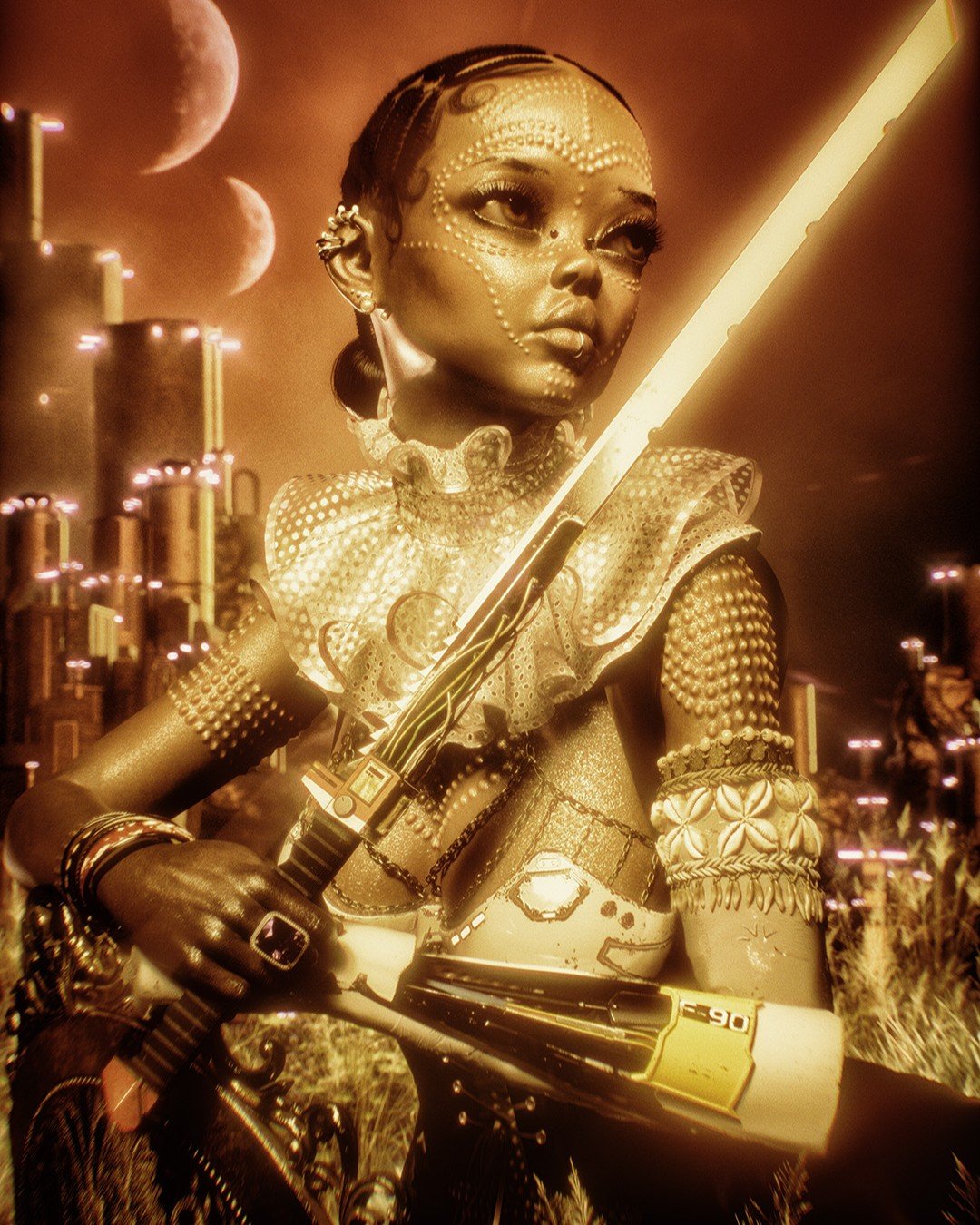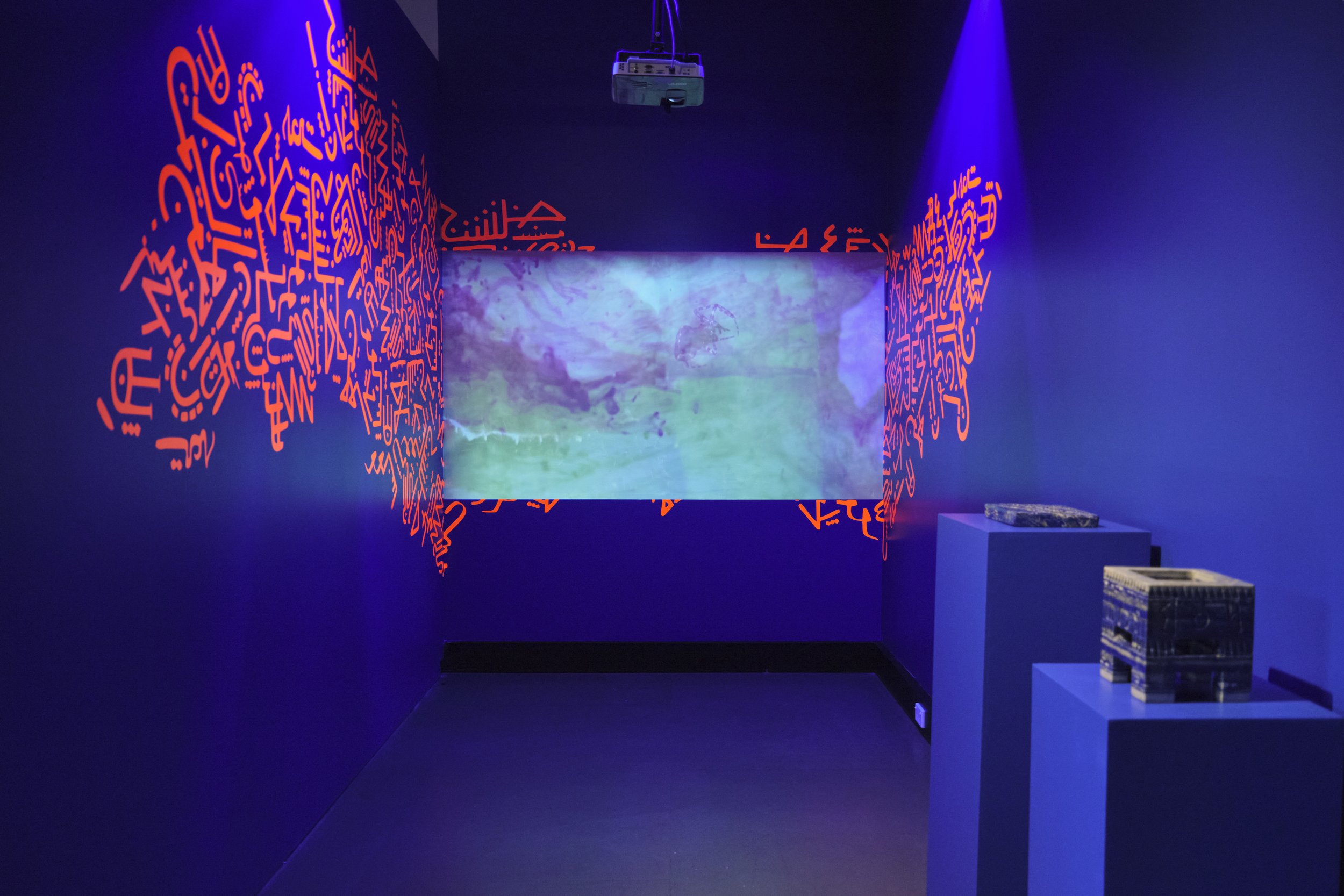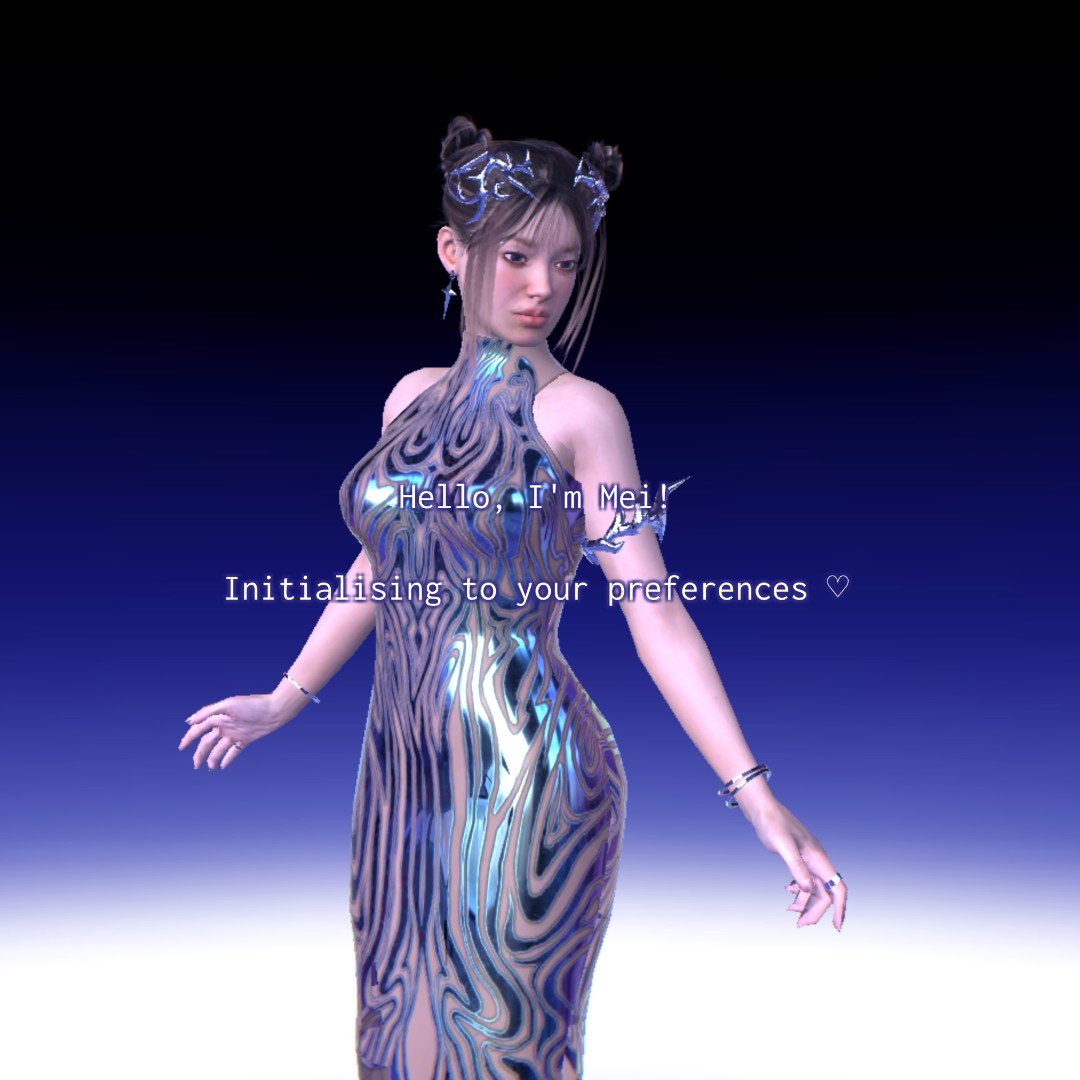
THE FUTURE BEGINS TODAY
“you have to go back to see the future”
In a time of constant flux, where grand pronouncements about the state of the future are ever pervasive, embracing ambiguity and seeking knowledge outside of the hegemonic framework becomes increasingly important. Multifutures, the multimedia group exhibition hosted at the Bankstown Arts Centre, presents a visually rich display that embeds migrant communities and their respective artistic practices in future narratives. Curated by Rachael Kiang, the Bankstown Art Centre Director, and produced with creative input by Michael Pham, Multifutures ‘is not an exhibition about the apocalypse’ and instead seeks to prompt contemplation and speculation about diverse visions of the future. Drawing on the lived experiences of First Nations and CaLD (Culturally and Linguistically Diverse) artists, the exhibition brings to the forefront the importance of diversity in the creation of imaginary and real-world futures. Including artistic practices informed by AfroFuturism, Indigenous Futurism, Asian Futurism and Yemeni Futurism, in an endeavour to present an alternate tomorrow that brings liberation from the hegemonic narratives that bind us to our contemporary existence. The exhibition presents artworks from International Artists including Alia Ali (US); Black Quantum Futurism (US); Subash Thebe Limbu (Nepal) as well as Australian Artists, Edwina Green; Jane Fan; Kalanjay Dhir; Lawrence Liang and Christina Lam, and Serwah Attafuah.
Futurism is an anticipatory movement that embraces and celebrates the dynamism and advancement of time, often looking past the now and hoping for answers in the future. Multifutures asks us to question ‘How does your today inform your tomorrow?’, addressing how the now structures the past, present and future. Many artists within the exhibition, such as Black Quantum Futurism, Jane Fan and Serwah Attafuah, reference the past to inform their depiction of the future, as Michael highlights “To build the future you have to have a past, without a past there is no future”.
As a world living in the height of the Anthropocene, many future focused exhibitions explore the ecological and economical crisis we face through a dystopian lens that aligns itself to Apocalypticism. The solutions presented to combat the imminent future are often drawn from a European or Anglo-Saxon perspective. Multifutures looks to subvert the futuristic thinking dominantly dictated by a white, patriarchal framework and demonstrate ‘a true reflection of [the] society we live in, a very plural world’. Curator Rachael adds that “It is about imagining a multitude of possibilities afforded by different ethnic and cultural experiences, layered with human and non-human agency''
Guest speaker Hannah Donnelly, proud Wiradjuri woman and Co-Artistic Director of Urban Theatre Projects, spoke at the opening night of Multifutures about the artworks as collective manifestations of the future and how the amalgamation of those can create new hybrid forms of future thinking. Speaking specifically to Indigenous Futurism, she signalled to what Western narratives fail to consider in their individualistic mindset; the ‘return to’ or greater importance of community. The exhibition, through Rachaels transcultural curatorial approach, offers representation for communities of South Western Sydney and beyond. Multifutures is particularly pertinent to the Canterbury Bankstown LGA as a culturally diverse area that hosts 129 nationalities speaking over 200 languages, a microcosm of contemporary Australia. Multifutures is “deeply important for the Bankstown community as there are a lot of the Vietnamese Immigrants… and a lot of our family history is oral based not documentation based due to the nature of the [Vietnam] war” says Michael. Bringing to the forefront speculative approaches as methodology that can intervene in the colonial processes of archiving certain communities.





Given the omnipresent nature of technologies and its infiltration into the everyday, its use as a medium harbours both aesthetic and political potential. As we propel towards a technologically dictated world, the pervasive nature of technology presents a double edged sword; it has allowed us to reshape our world-building capabilities as well as undermining a lot of the world that we once knew in terms of community, connection and environment. Multifutures is not a particularly high tech show and acknowledges that while modern technology offers affordances and is often synonymous with the more sci-fi idea of future, it is more about the concept rather than the medium. The lo-fi nature of the show is ‘in itself is a statement’ and allows artists ‘stretch their imagination and visual expression further’
The exhibition facilitated the Australian debut of Yemeni-Bosnian-US multimedia artist Alia Ali (Arabic: عاليه علي // Sabean: 𐩲𐩱𐩡𐩺𐩲|𐩲𐩱𐩡). Multifutures marking the first ever Australian exhibition by Alia with the presentation of The Red Star ‘5025’ (2020/2024) and Mahjar (2020). Her installation, a mixed media piece of photography, video, pattern and textile, explores themes of identity, diaspora and colonisation through the lens of Yemeni Futurism and feminist theory. The Artwork presents glow in the dark imagined characters inspired by the Arabic, Hebrew, and Sabean languages surrounding a projection of the film Mahjar.
Mahjar tells a dual narrative of the present reality of the ongoing violence enacted against Yemen as well as a future unshackled from the burden of imperialism and inspired by the Yemeni myth of Queen of Saba’a/Sheba. Alias’ work draws attention to oral history and language as a form of active resistance, as she challenges stereotypes of Arabic that link the language to geopolitical conflicts and discourses of criminality. Pioneering Yemeni Futurism, her layered film leans into archival footage of traditional Yemeni dancing, mythology and storytelling to move away from Arab Futurism and Gulf Futurism which is often characterised by an aesthetic of municipal master plans and stark avant garde megastructures.
‘Alia Ali is saying [that] there is a lot of Futurism that isn’t just technology based… it goes back to this overall kind of idea where the future is a circle and you have to go back to see the future.’
This departure from the sci-fi transhumanist trope sets the stage for the exhibition to follow as ‘Alia Ali is saying [that] there is a lot of Futurism that isn’t just technology based… it goes back to this overall kind of idea where the future is a circle and you have to go back to see the future.’
‘acknowledging that in spite of [it all] you can try and get some sense of power back for yourself and for your community’
Black Quantum Futurism Collective (BQF) is a multidisciplinary collaboration between Camae Ayewa (Rockers!; Moor Mother) and Rasheedah Phillips (The AfroFuturist Affair; Metropolarity) that focuses on intersectional futurism and time orientation, a practice that emerged from quantum physics and Black/African cultural traditions of consciousness, time and space.
Using holistic artistic and experimental methods Time Travel Experiments (2017) utilises an alternate temporal lens to entertain new methods through which to experience and engage with alternate realities. Their performances and DIY style of filmmaking engages time remapping that steers away from the linear Gregorian calendar and dictates a framework of time that allows for possible futures of preservation and recovery, rather than reinvention. Exploring personal, cultural and familial experiences as intersections of futures, their work focuses on positive activism to reclaim communal memories, histories and stories.
The transmedial expressions “acknowledging that in spite of [it all] you can try and get some sense of power back for yourself and for your community”.
Subash Thebe Limbu is a Yakthung (Limbu) artist from Yakthung Nation (Limbuwan) currently known as Eastern Nepal, his Yakthug name is Tangsang (Sky). Subash is a co-founding member of Yakthung Cho Sangjumbhjo (Yakthung Art Society) and Haatemalo Collective.
Subash explores the power of Indigenous futurism as a path of restoration and return through his film Ningwasum (2022). The film follows the story of time-travellers from a future where Indigenous knowledge and technology foster a sustainable lifestyle and interplanetary civilisation, acknowledging the integral part of Futurism that is cultural histories and practices. His practice works with sound, film, music and performance and is inspired by socio-political issues, climate change and indigeneity, writing speculative fictions of resistance and Adivasi Futurism, as he calls it. The underlying narrative of his futurism, for those in marginalised communities and those not imagined in mainstream literature. His film and practice at large, emphasising Hannah Donnellys’ comment that "Indigenous futures look like resurgence of languages and traditional territories". His blended and cyclical vision of Futurism, alongside those of Alia Ali, BQF and Edwina Green, showcasing that the distinction isn’t a “ harsh ‘Yes this is the future!’ [rather] it is this slowly easing in of different cultures”.
Serwah Attafuah is an artist and musician situated on Dharug Land who is known for creating cyber-dreamscapes and heavenly wastelands that situate themselves in the phygital; physical-meets-digital, reality we currently oscillate in. Her works are a visceral embodiment of the afro-futuristic abstractions of self with strong ancestral and contemporary themes of
decolonisation, freedom and resistance. The three mixed reality pieces from her ‘History of Tomorrow’ series, again invite us into a parallel timeline of a future that has already begun.
The pieces created alongside NFTS are ‘Portraits of Past, as I gaze into the Future’ as said by Serwah and can be brought to life through AR with the Artivive App. Similar to BQF, Serwah’s work addresses the fluidity of time and how the future is embedded into today. As Michael notes “When different time periods change, it’s a slow process, it is not like one day…boom it's the 1990s;
It is a slow bleeding of past, present and future”.
‘It is a slow bleeding of past, present and future’
Edwina Green is a Trawlwoolway First Nations artist based in Naarm whose mixed media practices focuses on reframing historical narratives to challenge understandings of indigeneity.
The artworks in Multifutures include a site-specific installation of printed textile and a video; ‘Missed Opportunity' and 'Smelter Slag', which bring ancestral stories to the present whilst examining connection to culture and intergenerational disconnection. The retro-futuristic use of collage and film photography and her deep understanding of colour theory was harnessed to bring to light ideas of community, language and the entanglement of lived experiences and memory in postcolonial environments. For Edwina, Indigenous Futurism is a big aspect of her practice “ because there is no choice. We’re creating works that our descendents are going to use as cultural protocol and [to]… understand the cultural climate that we as ancestors are existing in”.
Jan Fan is a software engineer and digital artist who works across illustration, 3D graphics, generative and interactive art. Her cyberpunk work ‘Dream Girl’ exposes the false sense of security, intimacy and control humans possess when navigating online spaces and engaging with AI. Upon first glance, the Ai character seems to fit into the stereotypical A.I. companionship tropes that are peppered throughout futuristic relationship discourse but as Rachael suggests “The medium is not always the message.. it really depends on…what the underlying narrative is”.
Concerned with the future implications of emerging technologies, ‘Dream Girl’ explores the parasocial relationships we have become accustomed to as we engage in daily transactional interactions with varying forms of technologies. Leaning into the intimacy of online relationships and the gamified nature of communication, the interactive work ‘Dream Girl’ is centred around visitor interactions with an artificial companion ‘Mei’.
Prompted by pre-cursor questions, ‘Mei’ initially adapts herself to the desires of the user, however challenges assumptions about the passivity of East Asian women by harbouring secrets, frustrations and a desire to ascend beyond her predetermined role. The AI persona ‘Mei’ is a bodily representation of the interfaces and algorithms that have become invisible with refinement of technology, the feminised algorithmic aesthetic merely a host for a larger commentary on the male gaze, hermeneutic relation and AI capability control.
Lawrence Liang is a first generation Australian Chinese Artist, Architect, Urban Designer, Structural Engineer and co-founder of ANL Design with Anson Li. Thuy Van/Christina Lam is a Vietnamese, Chinese and Cambodian Australian-born artist with an interior architecture background. Her interest lies in spaces within spaces and how they influence movement, emotions and memories using materiality, colours and shapes. As collaborators, their futurecosm in a terrarium is an immersive mixed media sculpture that invites visitors into a space to encounter a nostalgic reflection on the future. The diorama, framed by a turn dial TV and alive with moss, holds fictive futures displayed through blended scenes, each contrastingly unique and is a testament to the multiple strands of possibilities that could emerge in future. The space set up similar to a living room, positions visitors to encounter and reflect on experiences outside of their own, similar to what we must collectively do to ‘create new hybrid forms of thinking, being, living and making’.
Kalanjay Dhir is an artist and musician based on unceded Dharug Land, whose artwork ‘Coming Down’ uses physical hand-rod puppets as a didactic and speculative tool. Using puppetry as a precursor to cartooning, augmented reality and avatarisation in games, Kalanjay uses the puppet Gitu to prompt speculation on near futures; how can we live differently today that immediately affects the future of tomorrow? Hopeful about near future worlds, Kalanjay weaves fiction and art to comment on contemporary culture and investigate the way humans relate to their environment. Kalanjays’ fiction narratives abstract the language and gamification techniques of computer games as a form of storytelling to counter the increasingly untrustworthy and attention-deficit visual culture.
Presenting an exhibition that offers possibilities of future worlding alternate to archetypal futurist tropes, Multifutures “acknowledge[s] the contributions of different perspectives…and intellectual, creative and art making methods that come out of different cultures”. Multifutures is a rich visual and sound tapestry that “is looking at Futurism [in a way] that is accessible.. [and] is a great introductory point for the community of Bankstown [when thinking about] Futurism, technology and media arts”. The exhibition is an invitation to the community that demonstrates futuring as a responsibility we must all consider and should engage with as it contests the status quo of future worlding. After an offering of multifarious futures, stickers across the entrance way pose questions on the way we relate to time in a personal manner, prompting an initial thought or a final moment of contemplation. An extension of Black Quantum Futurisms ‘Time Zone Generators’, the questions give us an interpersonal lens with which to look at the future asking things such as ‘What is a song that reminds you of your past and is that song different from now?’ and grounding futures in “not just the bigger picture… [but] it is about you, your time [and] what is your relationship with that circle of time”. The idea that there is the chance to rewrite history and to inform the present and the future through asking ‘what does a future look like for you?’.
“An inclusive future will only work if people recognise not just a coexistence but how new possibilities and new worldbuilding models can happen through a transcultural methodology”
















Immerse yourself in the art through one of the upcoming Public Programs happening at Bankstown Arts Centre.
-
Make Your He(art) Beat with Jane Fan
Saturday June 22, 2 - 3pm
Join Jane Fan for a Media Arts 101, focusing on interactive and generative art followed by some creative coding. This workshop is open to all and is an opportunity to learn the basics of creating generative art and the extensive possibilities of free softwares available on the web.
-
Multifutures 3x3: Film Screenings
Saturday June 22, 3 - 4pm
The final triple bill screening of the works of three international artists, Subash Thebe Limbu (Nepal), Edwina Green (Melbourne) and Kalanjay Dhir (Sydney).
Conflict is More Profitable Than Peace | Alia Ali (US)
All Time is Local | Black Quantum Futurism (US)
Ningwasum | Subash Thebe Limbu (Nepal)
-
Futurecosm in Terrarium
Saturday 29 June, 11-1pm
Artist Lawrence Liang will lead you through the making of a Terrarium of the future.
-
Mapping the Future of Canterbury-Bankstown with Jess Montecinos
Saturday 29 June, 2-3.30pm
Bolivian-Australian artist Jess Montecinos will guide participants through a workshop that uses projection-mapping as a tool to imagine what the future of Canterbury-Bankstown might look like and how it could be constructed. Taking inspiration from the way in which the futures of the indigenous population of Aymara and Quechua are being imagined through Neo Andean Architecture/Futurism.
Multifutures | 11 May - 29 June
Bankstown Arts Centre
5 Olympic Parade, Bankstown NSW 2200
More Info: cb.city/MultiFutures
Contact: artscentre@cbcity.nsw.gov.au
Curatorial Team
Curator: Rachael Kiang [Arts Centre Director]
Creative Producer: Michael Pham
Public Program Producer: Emma Cao
Production Assistants: Kate Brown, Will Angus, Heath Lattre, Jessica Montecinos, Rachelle Esaid
Event Photography: Liam Black @lermphoto
Quotes sourced from curatorial interview with Rachael Kiang and Michael Pham.
Article and Interview by Joella Marcus.












